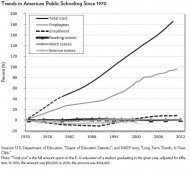 A Cato Institute study recently confirmed what School Choice advocates have long suspected. In spite of spending more per student, America’s public schools and student outcomes from that education, continue to decline. According to the study, “State Education Trends: Academic Performance and Spending over the Past 40 Years,” there appears to be no correlation between educational spending and student performance.
A Cato Institute study recently confirmed what School Choice advocates have long suspected. In spite of spending more per student, America’s public schools and student outcomes from that education, continue to decline. According to the study, “State Education Trends: Academic Performance and Spending over the Past 40 Years,” there appears to be no correlation between educational spending and student performance.
In the same time-period, congressional mandates have forced schools to provide other services to students. Today, schools must provide more comprehensive special education, after school programs, and, in light of advances in technology, new equipment such as computer labs for example. These new programs take a bite out of the educational budget. Still, private schools whose students still excel over public school attendees, operate at budgets about 34 percent lower than their state-funded counterparts. Public schools spend, on average, $11,000 per student per year.
The study, funded by the Cato Institute, (an independent, free market think tank based in Washington, DC,) also demonstrates that lowering of per-student spending doesn’t affect the overall student performance either.
“At one time or another over the past four decades, Alaska, California, Florida and New York all experienced multi-year periods over which real spending fell substantially (20 percent or more of their 1972 expenditure levels),” Coulson wrote. “And yet, none of these states experienced noticeable declines in adjusted SAT scores.”
The 60-page report verifies that since 1970, reading and math scores of American students have remained mediocre. According to National Public Radio, American students are not even in the global top 20 for math, reading, and science scores.
“That is remarkably unusual,” Coulson wrote, “In virtually every other field, productivity has risen over this period thanks to the adoption of countless technological advances that, in many cases, would seem ideally suited to facilitating learning. And yet, surrounded by this torrent of progress, education has remained anchored to the riverbed, watching the rest of the world rush past it.”
Viki is a political junkie, who believes that politics should never be a spectator sport. Over the years she has been a political opinion columnist for her local newspaper and an avid political blogger on the World Wide Web. In her determination to change the political environment of her small Mississippi town, she even published her own local political opinion newsletter for several years.
